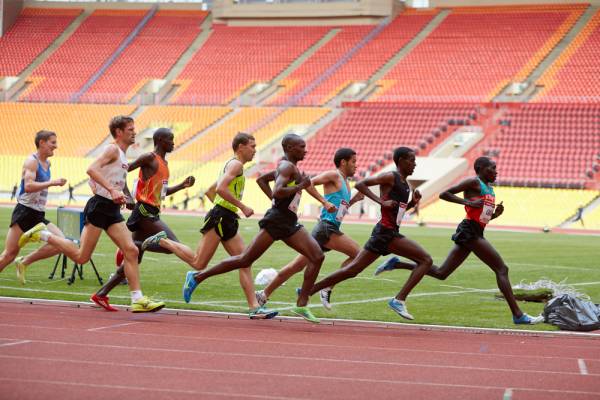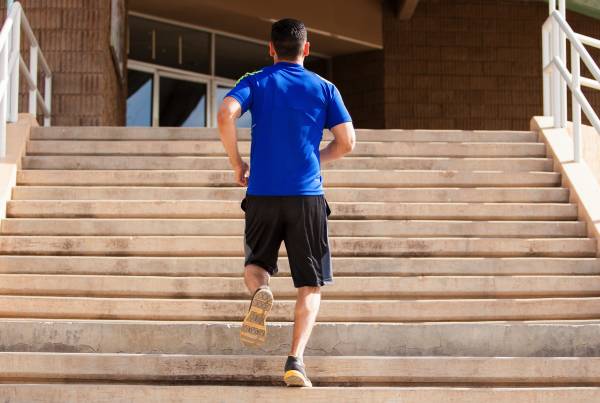A sprinter of mine recently lamented at a recurrence of his old right hamstring pain months after having surgery to it. He asked, “Is this likely to be a normal feeling as the other pain and numbness from the surgery subsides?”
His reaching out to me was accompanied by reflection on the deeper roots of the problem that led to surgery. I’ve found it increasingly common that athletes reinjure themselves.
The answers to his questions need to be independent of what we can see at first glance. Hamstring strength alone won’t be the sole indicator for readiness to return to play. We need to remember that the hamstring is not independent of what is above and below – that there is interdependence on the whole region.
Everything Is Related to Everything
There is a direct association between weak links at the ankle and hamstring strain. A much-cited research paper stated:
Regional interdependence refers to the concept that seemingly unrelated impairments in a remote anatomical region may contribute to, or be associated with, the patient’s primary complaint.
The Australian Football League Injury Report for 2013 reported an average 44.2 injuries per club affecting the leg from knee down. During this period there was a rise in calf and ankle injuries that occurred when rules to slow the game down were introduced two years earlier. The same report indicated an average of 34.7 knee injuries per club and 38.4 injuries affecting the hip, groin, or thigh.
“While sports medicine has improved in leaps and bounds, it’s clear we don’t yet have all the answers when one in five athletes suffer a relapse.”
Further, the recurrence rate of these injuries approaches 20% for some of those affected. While sports medicine has improved in leaps and bounds, it’s clear we don’t yet have all the answers when one in five athletes suffer a relapse. The statistics show that upper- and lower-leg injuries occur at roughly the same rate there is clearly a connection within the whole region that is possibly being glossed over.
So, what don’t we pay attention to at the ankle and calves that could be ruining running performance through injury?
Screen for Pain, Movement Restrictions, and Asymmetries
What we often don’t pay attention to are the basic principles of screening for pain, movement limitations, and asymmetries in areas away from the injury.
My sprinter also had a right ankle fracture/dislocation. So it’s stiff – showing much less than the required 35-40 degrees of dorsiflexion (bringing the top of the foot towards the shin). But here’s the thing – this stiffness is common in track sprinters and soccer players and can be beneficial if the stiffness is in the “spring” that is the calf and Achilles tendon.
However, when you get a joint that doesn’t glide and slide, the small nerves in the joint that require plenty of joint sliding and gliding can’t give instant feedback to coordinate muscle activity. These small joint nerves don’t get the opportunity to send signals up the leg.

Joint Stiffness Isn’t All Bad
If the stiffness in the ankle is from a stuck joint that occurs after a sprain, a pain of any type, or a more severe dislocation, then that’s not ideal. It may be something we can’t change and the stiff joint tissue might provide some of the spring needed. But often we need to stiffen up the other ankle to provide symmetry.
Here’s why – if you have too much uncontrolled movement in the ankle, the toe-off part of your stance phase is delayed, the leg travels too far underneath you, and you have a forward collapse of the pelvis. You have too much uncontrolled movement in the loose ankle.
“A forward rotating pelvis is a training error that leads to increased tension on the right hamstring if it’s the left foot that collapses.”
In running biomechanics coaching, we suggest “whipping from the hip and pushing your forefoot into the ground.” A loose and not-so-springy ankle isn’t doing this, so between the instant you first contact the ground and the instant there’s full pressure on your foot, there’s a mechanical collapsing, which inevitably causes too much dorsiflexion.
This cascades up the chain until you have too much forward collapse of the pelvis. A forward rotating pelvis is a training error that leads to increased tension on the right hamstring if it’s the left foot that collapses.
Develop Competency and Capacity
Get a screening to identify pain, movement limitations, and asymmetries. Have pain treated and mobility restored as much as possible. Remember, being flexible isn’t the same as being mobile. Then work with someone who knows running to develop foot and ankle static stability. Being mobile isn’t valuable unless it’s accompanied by motor control and stiffness in adjacent joints. Follow that with work on dynamic stability before you press on with a performance program. In other words, get fit at the ankles and feet to run before you run to get fit.
One of the simpler ways to do this is to follow this progression:
- Uphill walking or stairs walking on the ball of the feet with a progression to…
- Interval runs for short distance up hills or stairs, progressing to…
- Interval runs over less steep hills/stairs until the surface is flat. This strengthens the return to good technique after pain and injury cause bad patterns.

Don’t Ignore Your Limitations
Any problem with the feet or ankles will cause a problem further up the chain. Having pain in the feet or ankles shuts down the automatic running software loop that our bodies need for running. That means the loop is tainted and some kind of compensation will happen. It’s likely this compensation will stick around even when the pain is gone.
Gray Cook said, “If you ignore quality to get quantity, you’ll get neither.” Ignoring ankle and foot pain, mobility limitations, and asymmetries – even down to your big toe – will likely bite you in the backside just like it did with my athlete.
More Like This:
- 2 Drills to Injury Proof Your Ankles
- Ankle Mobility Secrets From Super D
- Reset Your Mobility With These 3 Essential Movement Patterns
- What’s New On Breaking Muscle Today
Photos courtesy of Shutterstock.






